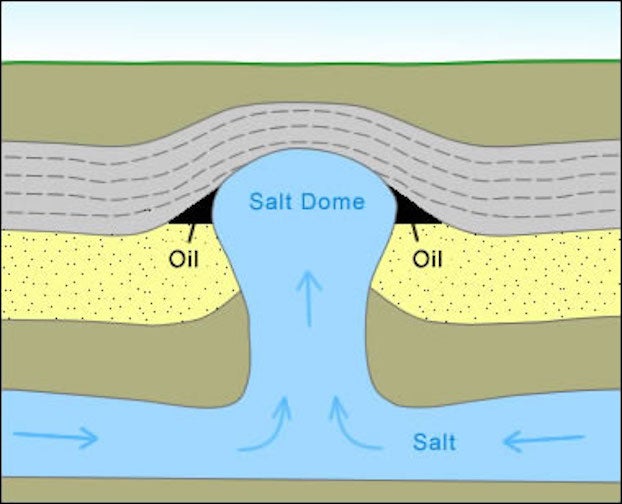Salt dome cavern not ‘past the point of no return’
Published 6:36 pm Tuesday, October 10, 2023

- (Photo courtesy of Geology.com)
Nothing the Office of Conservation has seen at the Sulphur Salt Dome thus far indicates the cavern “is past the point of no return,” according to Patrick Courreges, communications director for the Louisiana Department of Natural Resources.
In an email to the American Press, Courreges said a pressure anomaly that occurred in 2021 during routine monitoring led to the Department of Natural Resources stepping up its oversight at the Sulphur Salt Domes, a Westlake Corp. site.
“There are a variety of regular reports required by OOC, specifically to pick up when something is going wrong as early as possible,” Courreges said.
In 2022, PPG-7 (now a Westlake Corp. cavern) failed a Mechanical Integrity Test (MIT). Pressuring the cavern now requires constant pumping of salt water into the cavern. PPG-6 (now a Westlake Corp. cavern) has developed an obstruction in its well bore that is preventing more sophisticated tools into the cavern. It is, however, maintaining pressure.
PPG-6 and PPG-7 were used by the U.S. Department of Energy’s (DOE) Strategic Petroleum Reserve to store crude oil from 1978-1994. Much of the oil was removed when caverns were transferred to private industry, and an estimated 115,00-plus barrels remain, according to Courreges.
OOC reached out to local government and emergency response preparedness agencies to ensure they are up to date and to ensure the lines of communication are open if the need for quick action arises. Dick Gremillion, director of Homeland Security and Emergency Preparedness, said no further action has been taken as of Monday.
Local and state emergency preparedness agencies would come into play if the situation deteriorates into active cavern structural failure or release of hydrocarbons that could immediately endanger people and the environment in the area, requiring steps such as evacuations.
The core issue is that the Westlake Corp. cavern is unable to maintain a stable pressure and the OOC staff has documented a number of sites over the central and western areas of the salt dome where natural gas is bubbling up to the surface in water bodies and near wellheads, Courreges said. In addition, at least one oil seep has been detected and initial and gradual collapse or sinking has revealed a potential accelerating trend of downward movement. That is why the Declaration of Emergency was issued.
The worst-case scenario would be a structural failure, sidewall or top down or one of those triggering the other, leading to a sinkhole and the exposure of freshwater aquifers to concentrated brine and oil and other hydrocarbons.





